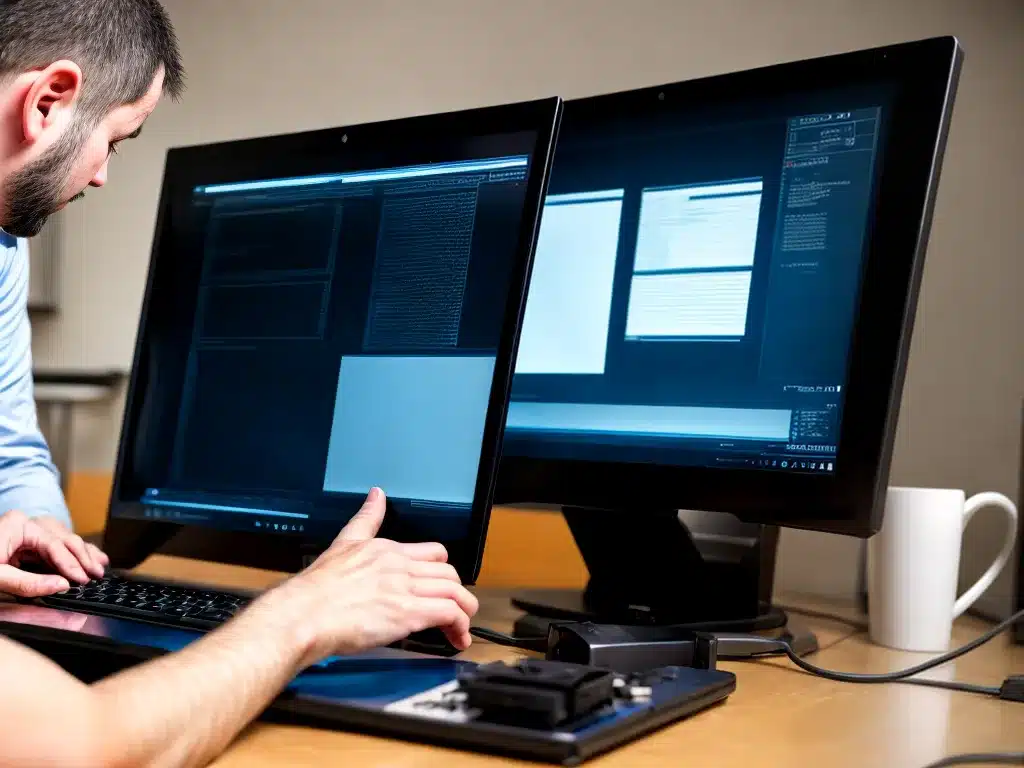
When I turn on my computer but see no image on the display screen, it can be frustrating and concerning. However, there are several troubleshooting steps I can take to diagnose and resolve the “no display” issue. In this article, I will provide an in-depth guide to troubleshooting a computer that powers on but shows no display.
Check Connections and Cables
The first thing I do when my computer turns on but the display is blank is to check that all the cables are properly connected. Here are some tips for checking connections:
Check Video Cable
-
Make sure the video cable connecting the monitor to the computer is securely attached at both ends. I wiggle the cable and press it firmly into the port to ensure a snug fit.
-
Verify I’m using the correct cable for the monitor and computer. Some use VGA, while newer ones may need an HDMI or DisplayPort cable. Using the wrong cable type will result in no video.
Check Power Cables
-
Check that the monitor and computer are both plugged into a power source and turned on. Make sure the cables are not loose or damaged.
-
For laptops, connect the AC adapter to charge the battery in case low power is the issue.
Reseat Components
- Remove and reinsert components like the memory sticks, video card, and cables to ensure a proper connection. Reseating components can resolve loose or faulty connections.
Adjust Monitor Settings
If the cables are all good, I check the monitor itself for correct settings. Here’s how:
-
Check the monitor power button is turned on and power LED is lit.
-
Toggle the monitor input source to match the computer connection type (VGA, HDMI, etc).
-
Look for any “source” or “no signal” messages on the screen. Refer to monitor documentation to change inputs if needed.
-
Increase monitor brightness to see if a faint image appears.
-
Try manually selecting analog/digital input on the monitor.
-
Reset the monitor to factory defaults in case incorrect settings are causing no display.
Test Computer and Components
To further isolate the problem, I test different parts of the computer:
Check Motherboard Connections and Lights
-
Examine motherboard for any lit diagnostic LEDs pointing to boot errors.
-
Reseat RAM and cables connected to motherboard.
-
Try removing non-essential components like extra hard drives.
Connect to Onboard Graphics
- If using a separate graphics card, connect the monitor cable to the onboard video connection on the motherboard instead. This bypasses the graphics card to test for signal.
Remove Graphics Card
- If onboard graphics change nothing, remove the graphics card completely and connect monitor to onboard video. Try rebooting without the graphics card installed.
Test with Alternate Monitor
- Connect the computer to a different external monitor or TV using the appropriate cable. If the alternate display works, the problem is with the original monitor.
Listen for Beep Codes
- Listen for any beep codes during boot which signal hardware problems. Look these codes up in the motherboard manual for diagnostic clues.
Boot Into Safe Mode
Booting into Windows Safe Mode loads minimum drivers and settings. Getting the display to show in Safe Mode can point to driver or setting issues. Here’s how I boot into Safe Mode:
For Windows 10 and 11:
-
Continuously press F8 as the computer restarts, selecting Safe Mode from the Recovery menu.
-
Or press Shift and click the Restart button in Settings, then choose Safe Mode.
For Older Windows Versions:
-
Press F8 during bootup and select Safe Mode.
-
Use System Restore or the Windows installation disc to access the Advanced Startup menu and get to Safe Mode.
Update or Rollback Graphics Drivers
Display problems frequently stem from buggy graphics drivers. I update or reinstall drivers in Device Manager.
Update Graphics Drivers
- Access Device Manager, expand Display Adapters, right-click the graphics card, and select Update Driver. This fetches the latest driver.
Roll Back Graphics Drivers
- If the problem started after a driver update, rolling back to the previous graphics driver often resolves issues.
Reset Monitor and TV Settings
If I’m still getting no video output after all the above steps, resetting all monitor and TV settings to factory default may fix display problems. Refer to device documentation for proper reset procedure.
Clean Install Graphics Card Drivers
If updating drivers does not work, I do a clean install of graphics drivers using Display Driver Uninstaller. This completely wipes existing drivers before reinstalling a fresh driver.
Test Hardware with Another OS
If the display works when booting from a Linux live USB or other operating system, then there may be OS file corruption. I can reinstall or repair the main OS installation.
Contact Manufacturer Support
For persisting no display issues, I contact the monitor, graphics card or computer manufacturer support. They can troubleshoot specialized or complex problems. I provide the make and model details, symptoms, and troubleshooting steps I’ve tried.
Summary
Fixing a computer powering on but not displaying anything involves methodically checking connections, display settings, components, drivers, and OS. Following the detailed troubleshooting tips above should help isolate and resolve my “no display” problems for computer turn on but no monitor signal issues. Let me know if you have any other suggestions for troubleshooting tips to add!












